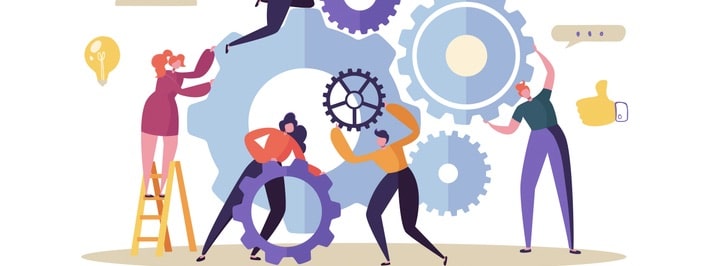No matter the size of your organization, creating personal development plans is crucial for business growth. According to research, more than three-quarters of employees are more likely to stick with an organization that offers continuous training.
Investing in your employee’s growth guarantees higher employee retention and engagement. How do you achieve this and create a development plan that works?
In this article, we’ll explain the best ways to build personal development plans so your employees can be more successful.
What is a personal development plan for employees?
A personal development plan is a growth framework that helps employees and their managers uncover growth opportunities, set realistic goals to fill them, and gather the necessary resources to accomplish them.
Why create personal development plans for employees?
Creating personal development plans for employees can be a colossal success driver for employee growth.
Personal development plans help employees look beyond their present work dynamics and improve their skills by reflecting on and evaluating their strengths and weaknesses.
Here are four reasons to create personal development plans for your employees:
1. Higher employee engagement, motivation, and retention
When employees have the chance to learn more about their aspirations, strengths, and weaknesses, identify growth areas, and receive support for working on them, this helps them see what’s possible. As a result, employees become more engaged at work, motivated to achieve higher goals, and more likely to stick with their organization.
2. Clear direction and focus
Creating personal development plans helps employees to have a clear path toward improving their performance, achieving their goals, and developing their skills. With a proper development plan template, employees can track, structure, and capture critical learnings throughout their development activities.
3. Skills development and better performance
A proper development plan helps employees develop their professional skills through learning activities. When employees improve their skills, they perform better at work and build on their experience.
4. Succession planning
Some employees may want to advance to a higher position in their organization. With personal development plans, employees can develop a succession growth plan highlighting the steps they need to take to climb the succession ladder.
How to create personal development plans for employees
Here are some tips to help you make employee development plans.
1. Conduct employee assessments to identify strengths and weaknesses
A part of personal development planning involves employee reflection. That means asking the right questions to help employees uncover their strengths, weaknesses, and areas they need to work on in their careers.
For instance, you can have employees participate in 360 reviews, peer evaluations, and self-assessments to answer questions that will help them determine their values, goals, interests, strengths, and weaknesses. You can include questions like:
- What do you want to accomplish?
- What are your strengths?
- What are your weaknesses?
- What areas of your professional career would you like to improve on?
- How do you intend to develop those areas of your career?
Feedback tools such as Effy and Zonka Feedback can help you automate this process. The employees’ peer and self-assessment will help them gain better insights into what they want to work on.
2. Help employees set professional goals
Once employees have identified gaps in their careers and future aspirations, HR managers can help them set realistic professional goals. In this case, employees should set short-term (three-six months) and long-term goals (one year) that align with the organizational goals.
When setting goals, employees can apply the SMART goal-setting framework. That means your employees set Specific, Measurable, Achievable, Relevant, and Time-Bound goals.
For example, an employee may have a professional goal of getting certified in software engineering in the next six months.
HR managers can provide development opportunities after the employees’ goals are set.
3. Develop action plans
It’s one thing to help employees set professional goals and another to help them take the necessary actions to achieve them. An action plan is essential to help employees develop their skills and achieve their goals.
Here are some ways you can accomplish that:
- Provide cost-efficient developmental training to develop knowledge, skills, and competencies
- Provide mentorship or coaching to enable employees to receive feedback and complete tasks that will improve their development
- Help employees lead by attending conferences that will provide more knowledge to advance their careers and avoid workplace issues.
4. Track progress and adjust if necessary
How will you know if your development action plans are paying off if you don’t measure progress? HR leaders must conduct performance reviews to collect employee feedback on their personal development journey.
Once you gather the necessary information, you can draw reasonable conclusions from it, identify areas for improvement or provide directives on how an employee can transition into a new role.
Conclusion
Personal development plans help employees tap into their potential and reach the next level in their careers. In the organization, employees need to be aware of what they are capable of and receive help to self-reflect and discover future career possibilities.
Through helpful discussions and questions, you can help your employees understand themselves better, set SMART goals, acquire relevant training, and learn to improve their competencies.
Remember, personal development is an iterative process. You must keep learning what works, track progress, and adjust as you progress.
FAQs
What is a good personal development plan?
A good personal development plan helps employees and their HR managers to identify gaps in their careers, set goals to fill them, and gather the necessary tools and resources to accomplish them.
What are examples of development plans for employees?
Some examples of development plans for employees include:
- Performance-based growth plan
- Skill-based growth plan
- Succession-based growth plan
- Leadership-based growth plan
How do you write employee development goals?
To write employee development goals, you should apply the following:
- Conduct employee assessments to identify strengths and weaknesses
- Help employees set professional goals
- Develop action plans
- Track progress and adjust if necessary




